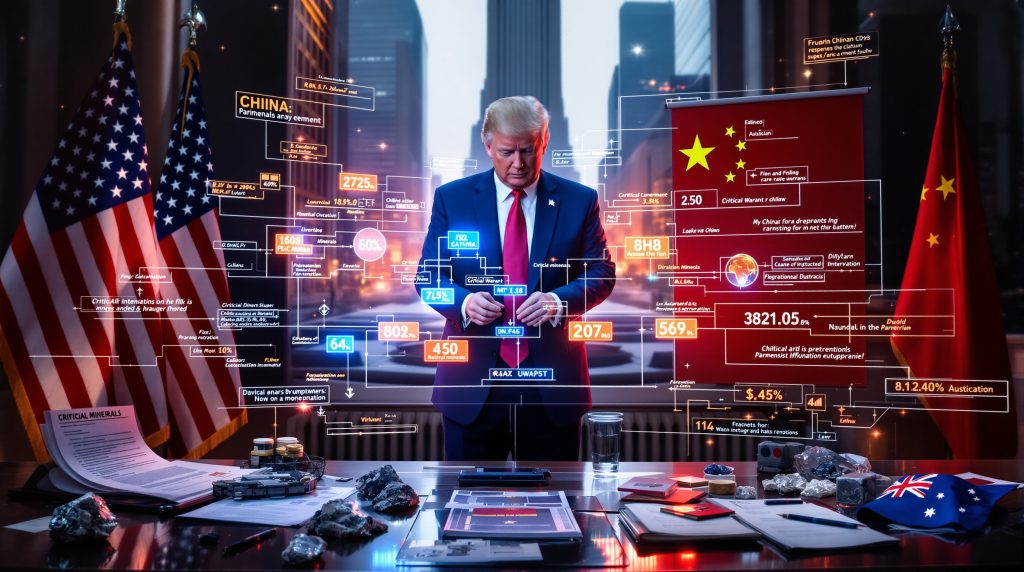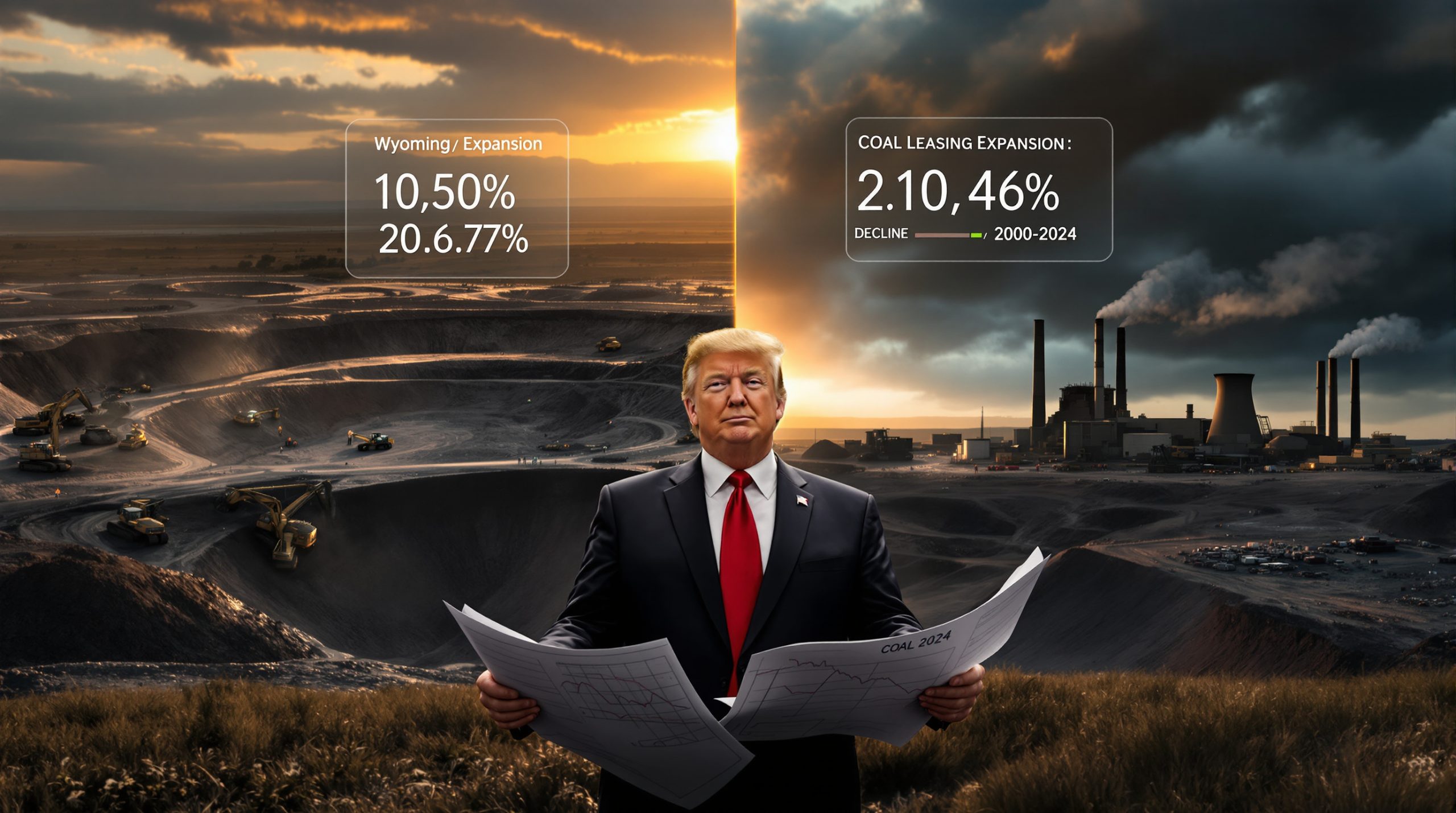Trump's New Strategy: Using Wall Street Tools to Secure Critical Minerals Supply Chain
The Trump administration is exploring innovative financial approaches borrowed from Wall Street to strengthen America's critical minerals supply chains. Rather than relying solely on traditional policy tools like subsidies or regulatory changes, officials are considering taking equity-like positions in strategic mineral producers through financial instruments like warrants—giving the government the right to purchase shares in these companies without immediate capital deployment.
This approach represents a significant shift in how the U.S. government addresses resource security, moving beyond regulatory frameworks to potentially become a direct stakeholder in the minerals supply chain itself. The strategy aims to secure access to materials essential for both defense applications and emerging technologies while reducing dependence on foreign sources, particularly China.
The Financial Innovation: Warrants as a Strategic Tool
Warrants represent a sophisticated financial tool giving the holder the right—but not the obligation—to purchase shares at a predetermined price within a specific timeframe. For the government, this approach offers several strategic advantages:
- Limited upfront capital requirements compared to direct equity purchases
- Potential for taxpayer returns if company valuations increase
- Ability to influence strategic decisions without full ownership
- Risk mitigation compared to direct investments
The use of warrants by the government isn't entirely without precedent. During the COVID-19 pandemic, the federal government took warrants in airline stocks as part of industry support packages. However, those interventions were temporary crisis responses, whereas the critical minerals strategy represents a longer-term structural approach to supply chain security.
A senior financial analyst familiar with government investment strategies notes: "The warrant approach provides the government with financial leverage while minimizing taxpayer exposure. It's essentially applying private equity tactics to national security challenges."
The Pentagon's $400 Million Blueprint
The Pentagon's investment in MP Materials Corp. earlier this year provides a template for how future government investments might be structured. This deal demonstrates the administration's willingness to deploy significant capital in the critical minerals sector.
Key features of this transaction included:
- Direct equity investment from the Department of Defense
- Focus on domestic rare earth processing capabilities
- Emphasis on creating a complete supply chain from mining to magnet production
- Public-private partnership structure with performance milestones
This unprecedented investment was reportedly led by senior defense officials with extensive private equity experience, bringing Wall Street expertise directly into government resource strategy.
Why Are Critical Minerals Suddenly a National Security Priority?
The elevation of critical minerals energy transition to top-tier national security status reflects growing recognition of supply vulnerabilities and their implications for both defense and economic security.
China's Strategic Leverage in the Minerals Market
Recent geopolitical tensions have highlighted America's vulnerability in critical mineral supply chains. China has demonstrated its willingness to use export controls on rare earth elements and permanent magnets as leverage in international relations.
According to U.S. Geological Survey data, the United States is 100% import-dependent for 17 critical minerals and imports more than 50% of its supply for 47 minerals. China controls approximately 60% of global rare earth mining and 87% of rare earth processing capacity, creating significant potential chokepoints.
This isn't the first time China has exercised its market power. In 2010-2011, China restricted rare earth exports, causing prices to spike by more than 750% for some elements and creating significant disruptions for manufacturers worldwide.
"The lessons from 2010 weren't fully internalized," explains a minerals policy expert. "What we're seeing now is a belated recognition that mineral security is inseparable from national security in an era of great power competition."
Beyond Defense: Economic Security Considerations
The strategic importance of critical minerals extends far beyond traditional defense applications. These materials form the foundation of modern economies:
- Electric vehicles require lithium, cobalt, nickel, and rare earths
- Renewable energy technologies depend on copper, silver, and specialized magnets
- Advanced electronics use dozens of specialized minerals in varying combinations
- Next-generation aerospace and transportation systems require high-performance materials
The intersection of energy transition goals, technological advancement, and national security has elevated minerals from commodity concerns to strategic priorities, driving unprecedented government intervention.
What Makes This Approach Different from Traditional Policy?
The warrant-based strategy represents a significant departure from traditional government approaches to resource security.
Unprecedented Government Market Participation
Historically, the U.S. government has used indirect tools to influence minerals markets:
- Research and development funding
- Defense procurement requirements
- Strategic stockpile management
- Tax incentives for domestic production
- Trade remedies against unfair practices
The shift toward direct equity-like investments signals a more interventionist approach focused on controlling supply chains rather than merely influencing them through regulation or incentives.
This represents part of a broader rethinking of the government's role in markets. As a strategic resources analyst explains: "The traditional tools weren't working fast enough. In a race for strategic resources, regulatory approaches move at bureaucratic speed while market control moves at market speed."
Part of a Broader Economic Strategy
The critical minerals initiative aligns with other recent interventions in strategic industries:
- Reported stake acquisitions in semiconductor manufacturing
- Strategic investments in domestic steel production
- Expedited permitting for projects deemed critical to national security
- Enhanced financing through government agencies
These actions collectively signal a more interventionist economic approach that places national security and supply chain resilience above traditional market efficiency considerations.
Which International Partnerships Are Being Leveraged?
The administration's critical minerals strategy extends beyond U.S. borders, recognizing that domestic resources alone cannot meet all requirements.
Australia as a Critical Strategic Partner
Recent meetings between U.S. officials and more than a dozen Australian mining companies highlight the international dimension of this strategy. Australia, with its rich mineral resources and strong security relationship with the United States, represents a natural partner in diversifying supply chains away from Chinese dominance.
Australia produces approximately 55% of global lithium and has significant deposits of rare earths and other critical minerals. Its established mining industry, stable political environment, and existing security ties make it an ideal partner for strategic mineral development.
These discussions reportedly included high-level administration officials driving critical minerals policy and were facilitated by Australian government representatives. Furthermore, Australia's critical minerals reserve has become a key component of this international cooperation.
Expanding the Allied Minerals Network
The Australia outreach appears to be part of a broader effort to create "friendly" supply chains among trusted allies. This approach parallels initiatives like the Minerals Security Partnership, which brings together countries including Australia, Canada, Japan, South Korea, and European nations to coordinate critical mineral development.
A mining industry executive involved in international mineral development notes: "What we're seeing is the formation of resource blocs aligned with broader geopolitical partnerships. The mineral map is being redrawn along security lines rather than purely economic ones."
This international dimension adds complexity to the strategy, requiring coordination of investment policies, trade rules, and diplomatic relationships across multiple countries and regions. The defence critical materials strategy further reinforces this allied approach to securing vital resources.
How Would These Financial Tools Work in Practice?
The mechanics of government warrant acquisitions would likely follow established financial practices while addressing unique public sector considerations.
The Mechanics of Government Warrants
Warrants are typically structured with several key parameters:
- Strike price: The predetermined share purchase price
- Exercise period: The timeframe during which the warrant can be exercised
- Coverage ratio: The number of shares each warrant can purchase
- Anti-dilution provisions: Protections against share value dilution
For government applications, these structures would need to balance taxpayer protection with strategic objectives. Key considerations might include:
- Pricing warrants to reflect national security premium rather than purely financial value
- Establishing governance rights even before warrant exercise
- Creating triggers related to supply assurance rather than just financial performance
- Ensuring transparent reporting on the government's position and exercise decisions
Financial experts note that structuring these deals would require specialized expertise not traditionally found in government. "The complexity is in balancing market-standard terms with unique government objectives," explains a capital markets specialist. "These aren't typical private equity deals."
Agency Coordination Challenges
Implementing this strategy involves multiple government agencies, creating potential coordination challenges. Companies in the sector report difficulties navigating which agency should be their primary point of contact:
- Department of Defense for military applications
- Department of Energy for energy transition materials
- Department of Commerce for trade-related issues
- White House direct engagement in strategic cases
This multi-agency approach requires careful coordination to avoid confusion and inefficiency. A minerals industry consultant observes: "Companies are getting different signals from different parts of government. There needs to be a single point of coordination to make this work effectively."
What Impact Will This Have on Domestic Mining?
The government's financial strategy could significantly impact the U.S. mining sector, which has faced challenges expanding despite growing recognition of mineral security concerns. The recent Trump executive order on critical minerals underscores this focus on domestic production.
Accelerating Project Development
Mining projects in the United States face lengthy permitting timelines, with new mines often taking 7-10 years from discovery to production. Government financial support could accelerate this process through:
- Enhanced access to capital for early-stage development
- Political support for permitting processes
- De-risking projects to attract additional private investment
- Creating assured demand through government procurement
These factors could particularly benefit projects that might not meet traditional commercial thresholds but serve strategic needs. As a mining finance expert notes: "Government backing fundamentally changes the risk profile for investors, making marginally commercial projects viable when strategic value is included."
Creating Complete Supply Chains
Beyond raw material extraction, the government strategy appears focused on developing complete mineral processing capabilities within secure jurisdictions. This vertical integration emphasis addresses a critical vulnerability: even when minerals are mined in friendly countries, they often must be processed in China before becoming usable in manufacturing.
Building these capabilities requires:
- Significant capital investment in processing facilities
- Development of specialized technical expertise
- Environmental permitting for processing operations
- Steady supply of raw materials to achieve economic scale
This focus on the full supply chain rather than just primary extraction represents a more sophisticated approach to mineral security than previous efforts. These approaches are driving mining industry innovation trends across the sector.
How Might Global Mineral Markets Respond?
The entry of the U.S. government as a strategic investor could reshape global mineral markets in significant ways.
Price and Supply Implications
Government intervention at this scale could fundamentally alter global mineral market dynamics:
- Creation of premium pricing for "secure" supply chains
- Development of parallel markets for strategic versus commercial applications
- Acceleration of new mining projects in allied countries
- Potential for oversupply if strategic investments exceed commercial demand
Market analysts suggest that strategic buyers may increasingly pay premium prices for materials from secure sources, creating tiered pricing in what have traditionally been global commodity markets. According to Bank of America projections, these dynamics could lead to significant price increases for metals like copper in the coming years.
Strategic Realignment of Resource Flows
The strategy may contribute to a broader realignment of global mineral supply chains:
- Formation of mineral security alliances among like-minded countries
- Development of processing hubs in strategic locations outside China
- Increased investment in previously marginal deposits in secure jurisdictions
- Potential for counter-investments by China to maintain market position
This realignment could effectively create two parallel systems—one optimized for economic efficiency and another for strategic security—with significant implications for pricing, investment patterns, and trade flows.
What Are the Key Challenges and Risks?
Despite its potential benefits, the warrant strategy faces several implementation challenges.
Implementation Hurdles
Executing this approach effectively will require overcoming several practical obstacles:
- Determining appropriate valuation and terms for warrant investments
- Creating transparent selection criteria for companies receiving investments
- Navigating government procurement and investment regulations
- Managing potential conflicts between commercial and strategic objectives
These challenges are magnified by the government's limited experience with these financial tools in strategic contexts. As a public policy expert notes: "The government doesn't have the institutional capacity to act like a private equity firm. Building that capability will take time and specialized talent."
Market and Political Considerations
The strategy also faces broader political and market risks:
- Potential political opposition to government ownership stakes in private companies
- International trade rule complications regarding government subsidies
- Risk of market distortions through preferential treatment
- Difficulty measuring success beyond financial returns
The warrant approach walks a fine line between strategic investment and industrial policy, potentially creating tensions with both free-market advocates and trading partners.
FAQ: Critical Questions About the Critical Minerals Strategy
What specific minerals are being targeted?
The U.S. Geological Survey identifies 50 minerals as "critical," but government attention appears focused on those with the most significant supply vulnerabilities and strategic applications:
- Rare earth elements for permanent magnets and defense applications
- Battery materials including lithium, cobalt, nickel, and graphite
- Specialized metals like titanium, tungsten, and strategic aluminum alloys
- Processing capabilities for converting raw materials into usable components
The strategy appears to prioritize minerals with direct defense applications while recognizing the growing convergence between military and civilian technology requirements.
How does this approach compare to other countries' strategies?
Major economies are pursuing diverse approaches to mineral security:
- China has long used state-owned enterprises and strategic stockpiles
- The European Union established the Critical Raw Materials Act to secure supplies
- Japan has deployed government financing for overseas mining projects
- Australia has developed a Critical Minerals Strategy prioritizing downstream processing
The U.S. warrant-based approach represents a hybrid model between direct state ownership and pure market mechanisms, reflecting America's mixed economic traditions.
What timeline is expected for implementation?
Based on recent developments, several near-term actions appear likely:
- Formalization of investment criteria for potential warrant acquisitions
- Development of a coordinated interagency process for evaluating opportunities
- Engagement with additional international partners beyond Australia
- Potential announcement of new investment deals following existing models
Industry analysts expect the strategy to unfold over several years, with initial investments focusing on the most critical supply vulnerabilities before expanding to broader mineral security concerns.
How might this affect consumer products and prices?
The strategy's impact on consumer markets will depend on implementation details and market responses:
- Short-term: Potential price increases as production shifts to higher-cost jurisdictions
- Medium-term: Potential price stabilization as new supply sources come online
- Long-term: More resilient but potentially higher-cost supply chains
The ultimate cost impact will depend on whether security premiums remain confined to strategic applications or spread throughout mineral markets.
Further Exploration
Readers interested in learning more about U.S. critical minerals policy can also explore related educational content on MINING.com, which offers perspectives on global mining industry developments and critical minerals markets.
Ready to Spot the Next Major Mineral Discovery?
Discovery Alert's proprietary Discovery IQ model provides instant notifications on significant ASX mineral discoveries, helping investors capitalise on opportunities before the broader market. Explore how historic discoveries have generated substantial returns by visiting our dedicated discoveries page and begin your 30-day free trial today.




